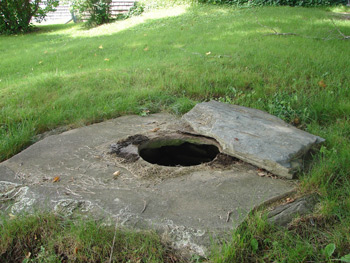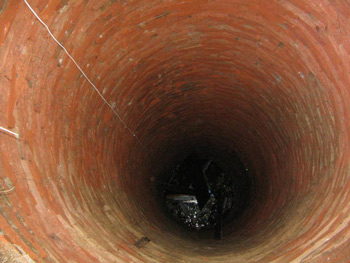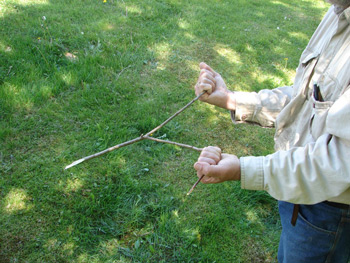The Other Well: Dowsing, Facts And Fables
by Tom Seymour

A dowsed, hand-dug well on the lawn of a farmhouse. It has a large, flat stone on top and a hole cut out for hauling a bucket. The smaller, flat stone is to keep it covered so nothing falls into it. Hand digging was not only very laborious, but there was the danger of the wall collapsing on the excavators. Tom Seymour Photo
The American Heritage Dictionary describes a divining rod as, “a forked rod believed to indicate underground water or minerals when held over a source.”
This use of the word, “divining” stems from an ages-old misconception, one that has long shed an unfavorable light over dowsers. Scripture contains various prohibitions against divination, or the process of attempting to foresee the future. This explains why the seer and astrologer, Nostradamus, buried his predictions in the form of quatrains, or four-line stanzas. To do otherwise would have placed him in grave peril from church authorities.
But the blue jean and flannel-clad dowser who cuts a forked switch and walks about looking for a source of water for a farm pond bears no resemblance to seers, prophets or astrologers. That person only wishes to find water and for those who possess the gift, dowsing answers that need perfectly.
Going ahead in time, let’s consider our early colonists. These people cast their lots in a new land. They were, by and large, farmers, individuals and families who would put down roots, till the land and establish communities. And, of course, they needed water.
Anyone who has ever examined one of the many thousands of hand-dug wells spread over the backwoods of New England can easily appreciate the difficulty involved in the procedure. Often, these wells were 15- to 20-feet deep and lined with huge, flat stones on the bottom and along the sides. Two men, working with a team of oxen, could easily spend months digging and laying rocks for a new well.
Given the time, effort and expense involved in creating a well (there just weren’t any motorized well drillers back then), can anyone honestly believe that our ancestors would have chosen the location for their wells totally at random? Hardly.
Traveling Dowsers
Our founders were practical to the utmost degree. They had to be, since their lives depended upon it. So before engaging workers and teams to make a well, the landowner needed a reasonable expectation that the thing would not wind up a dry hole. Enter the itinerant dowser.
Dowsers, professional men who had the art of dowsing down to a very real science, often traveled from community to community, much the same way as ministers and circuit judges would do later on. In addition to whatever pay they received, the dowsers would stay at the homes of those who engaged them for their water-locating services.
Many dowsers achieved a certain degree of fame and their talents were much in demand. Thus, many people were willing to wait for these individuals to visit their region, rather than going on the advice of those less skilled in the art.
Contrary to myth and legend, rarely do people dig upon a dowser’s advice and have water burst forth like a fountain. Instead, the water dowser’s stock in trade lies in locating underground veins. These may not be much bigger in diameter than a common pencil. But a good vein, once opened, can pump lots of water and as it does, it expands.
Dowsers can pinpoint these veins and even determine their depth and direction of travel. Once located, the person digging the well must take pains not to deviate from the spot that the dowser has marked. In the case of relatively deep sources, a plumb line becomes necessary. That’s because the greater the distance down, the greater becomes the chance for error. Missing a vein by only a few inches can mean a dry well.
Modern Applications
Modern well drillers do not exploit these underground veins. In fact, most professionals refer to them as, “surface water.” The connotation here implies some inherent impurity. But these veins are not surface water in a strict sense of the word. They originate underground and that’s where, for the most part, they stay. On the rare occasion, a vein may wind near the surface, creating a wet spot.
And rather than being some sort of second-rate source of water, underground veins may present certain health benefits lacking in water from deeper, drilled wells. First, radon, a colorless, tasteless but toxic gas, often exists deep underground and can be present in deep wells. Homeowners must constantly test their environments for radon and if present, take expensive, preventative measures.
Also, deep, or drilled wells sometimes tap into water that contains an over-abundance of minerals. This “hard water” often has an off-taste and even an offensive odor. Also, such water can contain iron deposits that stain clothing and dishes and finally, hard water makes it difficult for soap to form a good, lather.
While there are no hard-and-fast rules, most dowser-located wells contain soft water, perfect for showering and cleaning.

Brick lined well. Deep dug wells were dug wide at the top in a reverse cone. They were then lined and backfilled behind the more vertical stone or brick lining. Tom Seymour Photo
Theories Abound
Why does dowsing work? What makes the stick point down toward a water vein? There are more answers to this than there are individual dowsers. One common, but unproven theory states that it is electricity in the human body that dowsers somehow channel to the rod. But how can electricity, even the organically-produced kind in our bodies, make a stick do anything? It can’t. The answer lies elsewhere, but unfortunately, nobody has yet offered a demonstrable explanation.
So while we really don’t know why dowsing works, we can safely point out that indeed, it does work. And for most of us, especially those wishing to dig a farm pond or water well, that’s enough.
Before getting into specifics of how to dowse, it is important to know that dowsers can’t make water appear where it does not already occur. Here’s a typical example of what sometimes happens. A person needs a well and consults a dowser. “I would like it right here, the landowner says, pointing to a specific spot.”
The dowser, of course, must explain that if a vein exists there, then a well is possible. But if there is no water, there is no water. Those in need of water too often overlook this pure and simple fact.
On the other hand, well drillers tap into something called, “water-bearing strata.” Ask someone to drill a well in a specific location and eventually, if they go deep enough, they will likely sink their bit into a wet layer.

Hold Forked Rod With Palms Up, Fists Clenched. Tom Seymour Photo
Forked Sticks
The traditional forked stick works as well today as it did millennia ago. These should be flexible, yet strong enough not to crack or split under pressure. Some favorite sources include weeping willow (the most sensitive and easiest to use), cherry, apple and alder. Other woods do not work well and are best avoided.
Next, select the most symmetrical fork available. Look for a perfect, “Y” shape. The two upper parts of the Y we’ll refer to as left and right limbs. The perpendicular bottom end of the Y is the pointer.
Standing with feet slightly apart and in an upright, comfortable position, grab the left and right limbs in either hand, with palms upright. Settle the rod so that after firmly clasping the limbs, the pointer is horizontal with the ground. Slightly spread the limbs so as to exert a light pressure.
Now, slowly walk forward, at all times keeping the limbs spread and the pointer perfectly horizontal. Some feel that it helps to envision water while doing this. It certainly doesn’t hurt.
If a vein is present and within a reasonable distance of the surface, the stick will slowly bend down as the dowser draws nearer. When the stick points directly down, stop and mark the spot. It helps to have a brightly-colored object, a bit of flagging, for example, to do this.
Now back off and walk toward the spot again. Then try from other directions. If every attempt results in the same finding, that indicates an underground vein of water.
While some dowsers are able to determine depth simply by the feel of the rod, many others must resort to a more reliable device. For this, obtain the tip end of a light or medium-weight, fishing rod. Hold the rod by the tip, or small end, with (for right-handers) the right hand firmly held against the waistline and the left hand above the right hand, both grasping the rod. Make sure the tip is horizontal and then, move about so that the end of the rod is directly above the mark. Hold the rod as firmly as possible and try not to allow to wiggle. Nevertheless, in a short time, the rod will begin to bounce up and down. When it establishes a steady rhythm, start counting. The rod will eventually stop of its own accord. The number of bounces from the point of counting translates to the depth of the vein in feet.
Some dowsers use manufactured devices to locate not only water, but also minerals, pipes and so on. But for the beginner who is only interested in finding an underground vein, the old, forked stick will do the trick.
